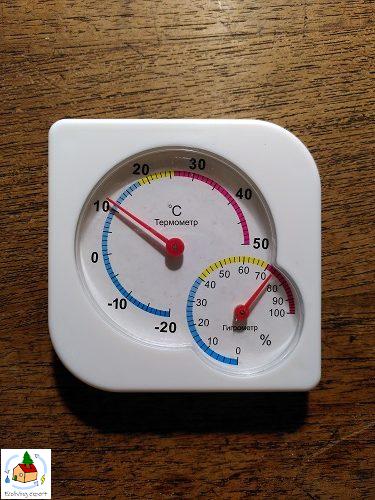You need a dehumidifier when the relative humidity level of your indoor air is regularly above 60%. This can be measured with a hygrometer. Indicators of high humidity levels are condensation on windows or walls, low thermal comfort, the presence of mold growth, dampness, and musty odor.
A dehumidifier removes water vapor from the air to lower its relative humidity. Therefore, you only need a dehumidifier when you have levels of humidity that are too high.
The ASHREA (American Society of Heating, Refrigerating and Air-Conditioning Engineers), recommends indoor relative humidity levels do not exceed 65%. This is based on microbial and mold growth preferring humidity levels above 65%.
On top of that, high humidity can damage paper, cloth and wood. For personal thermal comfort, relative humidity between 30 and 60% is recommended. People with allergies or lung conditions also benefit from optimal humidity levels.
ASHREA recommends that relative humidity in
ASHRAE Standard 62.1-2016 r (source)
occupied spaces be controlled to less than 65% to reduce the likelihood of
conditions that can lead to microbial growth.
How to know if you need a dehumidifier
Measure it! The easiest way of knowing whether you need a dehumidifier is to measure the relative humidity in the room. This is done with a hygrometer. A hygrometer is often included in a thermometer.
The picture below shows my cheap thermometer that has a hygrometer as well. The hygrometer is the smaller display in the bottom right. It shows the percentage of humidity in the air. (The thermometer is in degrees celsius)

This picture shows the low temperature and high humidity levels common during winter in the Netherlands. Since the humidity levels are above 70%, I clearly should run a dehumidifier.
For more information about relative humidity, I recommend reading my article about it.
Indicators of high humidity
There are several telltale signs that indicate you need a dehumidifier. You won’t always need to measure the relative humidity first. These indicators are:
- dampness and condensation
- poor thermal comfort
- the presence of musty odor
- the presence of mold
- laundry does not dry as quickly
Dampness and condensation
Dampness is a clear indicator of high moisture levels in the air. Although dampness can have many causes such as leaks, rain and local climate, they are all indicators of humid air.
Condensation is another clear indicator of humid air. Condensation occurs when water vapor in the air becomes liquid because the air is saturated. This happends when it cannot hold any more water, or in other words, when the relative humidity level is 100%. When the air cools down, the air can’t contain as much water, and water vapor starts to form condensation. This often occurs on cold surfaces such as windows.
Another indicator that your air is very humid is when you are boiling water and a lot of water vapor is produced. The hot water vapor from the water cooker is mixed with colder humid air, and full saturation is reached. At this point, the water vapor turns to liquid water. Therefore, we can see it as water droplets or mist.

Poor thermal comfort
Alongside the temperature of the air, the relative humidity level determines our thermal comfort. Thermal comfort means how comfortable we feel in the air around us. We feel comfortable at temperatures around 65 to 78 degrees F (18 – 25 degrees C) and humidity levels between 30 and 70%.
Humidity levels determine how we experience the temperature of the air. For example, when the air is hot and humid, we feel extra hot because we have trouble losing heat through sweating.
Also, we feel extra cold when the air is cold and humid because high humidity causes us to lose heat quicker. This work similarly to the feeling of being cold when you are wet and feel wind chill.
So, if you experience poor thermal comfort although the temperature should be comfortable, chances are the levels of humidity are too high.

The presence of musty odor
The presence of musty odor can be another indication of humid air. Musty odor normally occurs when the air is too humid or there is water indoors. For example, because of a leak or standing water in the basement. The odor can happen because of rotting wood, cloth, or the presence of mold. Since humid air is more stagnant, odors tend to linger.
The presence of mold
Mold or mildew growth is a clear indicator of too much moisture. Mold can grow in places that are often wet, such as the basement or the bathroom. It prefers humidity levels above 70%.
If you have mold growth in other places, you should check for a source of water. If a source of water (a leakage for example) is not clearly present, you likely simply have very humid air. In that case, purchasing a dehumidifier can help reduce and prevent mold growth. If you are considering purchasing an appliance to help fight mold, I recommend reading my article about it first:
Laundry does not dry as quickly
Another indicator of humid air can be that your laundry does not dry as quickly as normal. It’s hard to tell how quickly laundry should dry. However, you might know what is normally the case at your home. When suddenly the laundry doesn’t dry as quickly as expected, you might have a problem with humid air.

Conclusion
High humidity can have a negative impact on your health, comfort, and well-being. On top of that, it can cause damage to your home.
To find out if you need a dehumidifier, you can either measure the relative humidity of the room or look for signs of humid air.
When you are ready to purchase a dehumidifier, I highly recommend checking out my article on what to look for in a dehumidifier. There are two types of dehumidifiers, and there are many optional features that you might want to look into. Check out my helpful guide here:

